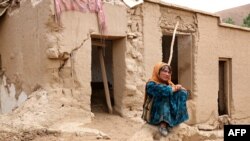
Welcome back to The Azadi Briefing, an RFE/RL newsletter that unpacks the key issues in Afghanistan. To subscribe, click here.
I'm Mustafa Sarwar, a senior news editor at RFE/RL's Radio Azadi. Here's what I've been tracking and what I'm keeping an eye on in the days ahead.
The Key Issue
At least 13 people have been killed and dozens injured in torrential rains and flash floods that struck a dozen provinces in Afghanistan.
The worst-affected areas were in the central province of Ghor, a remote and impoverished region where at least six people died.
Three women and a child from a single family perished in a village outside the provincial capital, Firoz Koh.
"The flood came suddenly around noon," Agha Jan, a neighbor of the victims, told Radio Azadi on May 24. "They could not get out of their home. Four people were killed, and one person is still missing."
Why It's Important: Hundreds of Afghans are killed every year in torrential rains, landslides, and floods, particularly in rural areas where poorly built homes are often at risk of collapse.
The United Nations has said that decades of war, environmental degradation, and climate change have made a growing number of Afghans vulnerable to natural disasters.
The latest floods are likely to exacerbate the devastating economic and humanitarian crisis in Afghanistan, where millions are on the verge of starvation.
What's Next: It is unclear if the flood victims in Ghor will receive much-needed assistance.
Matthew Miller, the spokesman for the U.S. State Department, recently said that aid programs in Ghor and two other provinces had been discontinued by Washington and its partners due to "Taliban interference with humanitarian activities."
Nizamuddin, a resident of Ghor, pleaded for help. "The local government should address the problems of the people. Our houses were destroyed and people have been killed."
The Week's Best Stories
Afghanistan's extraordinarily high maternal mortality comes with the territory in a country marked by political upheaval, economic woes, and cultural restrictions, all of which have limited women's access to adequate health care. But while the Taliban government says the numbers of women dying during childbirth are holding steady, the conditions are ripe for disaster.
The Taliban is trying to revive the Afghan Air Force by using and repairing aircraft inherited from the former Afghan government. But the scarcity of trained pilots, a spate of deadly accidents, and international isolation are hampering the effort.
What To Keep An Eye On
Jan Egeland, the secretary-general of the Norwegian Refugee Council, said the Taliban had agreed to negotiate exemptions that would allow female Afghan aid workers to resume work in the southern province of Kandahar.
In December, the Taliban banned Afghan women from working for local and foreign NGOs, in a move that led international organization to cut or end their operations in Afghanistan.
Egeland, who met with Taliban leaders this week, said he hoped that any exemption in Kandahar would be extended across the country.
"We cannot and will not work with male [staff] only," Egeland told Radio Azadi on May 25. "We would not be able to reach women in need with male [staff] only. So, I'm hopeful that we will get these exemptions and then that will be a breakthrough."
Why It's Important: The Taliban's ban on Afghan women working for NGOs has affected the delivery of humanitarian aid, including food assistance, to millions of people.
The hundreds of Afghan women employed by foreign NGOs are critical in delivering life-saving aid in Afghanistan, where the UN said nearly three-quarters of the population of 40 million needs assistance.
That's all from me for now. Don't forget to send me any questions, comments, or tips that you have.
Until next time,
Mustafa Sarwar
If you enjoyed this briefing and don't want to miss the next edition, subscribe here. It will be sent to your inbox every Friday.




